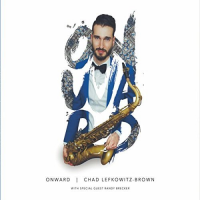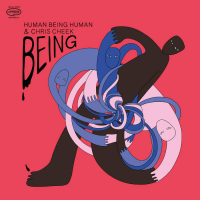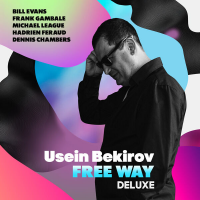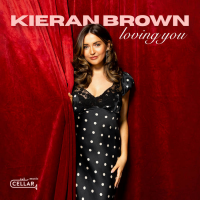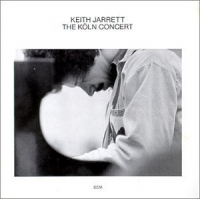Home » Jazz Articles » Extended Analysis » Chick Corea: The Musician
Chick Corea: The Musician
Not Chick Corea.
When this renowned pianist/keyboardist, composer, bandleader and guest participant in countless projects since emerging on the scene in the early '60s—Cab Calloway was his first professional hire, but was quickly eclipsed by gigging and recording with Blue Mitchell, Herbie Mann, and Latin musicians Mongo Santamaria and Willie Bobo—turned 60 in 2001, this living legend of Italian and Spanish descent chose to make his birthday celebration a public one by booking three weeks at New York City's heralded Blue Note club.
With a roster that included nine groups ranging from intimate duos to full-blown sextets featuring a total of twenty invited musical friends, Corea delivered a career-spanning series of shows that ranged from the trio responsible for an early classic, Now He Sings, Now He Sobs (Solid State, 1968), to the pianist's then-more recent groups: the quintet responsible for Remembering Bud Powell (Stretch, 1998); and his Origin sextet, which prolifically released two albums and a six-CD box set between 1998 and 1999. Highlights from the performances were collected on the two-CD Rendezvous in New York (Stretch, 2003) set, but a more satisfying document was to come two years later, when Corea released a ten-DVD box, also called Rendezvous in New York (Image Entertainment, 2005), that, in addition to hour-long concert videos from each of the event's nine groups, also included Rendezvous in New York: The Movie, a 100-minute documentary about the event and Corea's career, narrated by actor Jeff Goldblum.
If there was any complaint about Rendezvous in New York, in all its iterations, it was that this momentous 60th birthday celebration focused exclusively on Corea's work in the acoustic arena. Any who've followed his career know that he's been an equally active contributor to more electrified jazz, and that any true career-spanning event would also have to include at least some references to that aspect of his life's work.
First, there were his various incarnations of Return to Forever: beginning as the lighter, Latin-infused quintet responsible for Return to Forever (ECM, 1972) and Light as a Feather (Polydor, 1973); morphing into the high-octane, high-volume guitar-driven fusion quartet that released four albums from Hymn to the Seventh Galaxy (Polydor, 1973) through Romantic Warrior (Columbia, 1976); and, finally, ending its '70s tenure as the horn-infused ten-piece which contributed the studio outing Musicmagic and far more satisfying but still too-short single-LP Live, both released by Columbia in 1977, followed the next year with the even more impressive (and welcome) Return to Forever Live: The Complete Concert (Columbia, 1978).
Not unlike fellow pianist Herbie Hancock—with whom Corea played in a duo in the late '70s, releasing the double-LP An Evening with Herbie Hancock and Chick Corea: In Concert (Columbia, 1978)—Corea's subsequent career has been a mixture of acoustic and electric projects. In the '80s/'90s he formed a new Elektric Band (which featured a number of talented up-and-coming musicians including guitarist Frank Gambale, saxophonist Eric Marienthal, bassist John Patitucci and drummer Dave Weckl) while, at the same time, releasing acoustic projects including, amongst others, the reunited Now He Sings, Now He Sobs trio with bassist Miroslav Vitous and drummer Roy Haynes; his Akoustic Trio with Patitucci and Weckl; a duo record with singer Bobby McFerrin; and, while touring every year since their inception as a duo in 1972 and 1973 ECM debut, Crystal Silence, releasing his first album with vibraphonist Gary Burton in 15 years, Native Sense—The New Duets (Concord, 1997).
Truly one of jazz's most prolific—and, with rare exception, most consistently impressive—artists, Corea continued into the 21st century with a combination of reunions, ongoing collaborations and new projects.
In addition to reuniting his Elektric Band for To the Stars, two different Return to Forever tours brought Corea some of his largest audiences in years: the first, with the "classic" Al Di Meola/Stanley Clarke/Lenny White lineup, releasing both Returns (Eagle Records, 2009) and the video document Returns—Live at Montreux 2008 (Eagle Eye, 2009); and the next, bringing Corea, Clarke and White back together, but this time with Gambale and violinist Jean-Luc Ponty in tow, as the even more enjoyable RTF IV, which delivered the audio/video set The Mothership Returns (Eagle Rock, 2012).
Duets with Burton continued on the Grammy Award-winning The New Crystal Silence (Concord, 2008), while new parings with banjo master Bela Fleck and pianists Stefano Bollani and Hiromi all bore new and intriguing fruit. Corea continued his love affair with the Flamenco/Spanish music, first explored most decidedly on My Spanish Heart (Polydor, 1976), with renowned Spanish musicians including bassist Carles Benavent and saxophonist/flautist Jorge Pardo on Rhumba Flamenco—Live in Europe (Stretch, 2005) and continued to mine the familiar terrain of the piano trio with a series of new groups both acoustic and electric, some collected in his Japan-only Five Trios (Stretch, 2007) box, others documented on the similarly Japan-only Super Trio (Stretch, 2006), and, most recently, the worldwide Trilogy (Concord, 2014). And, not to forget new electric explorations, Corea also released the conceptually driven Ultimate Adventure (Stretch, 2006); his first post-Miles Davis) group collaboration with guitarist John McLaughlin as Five Peace Band, releasing Five Peace Band Live (Stretch, 2009); and forming a new, high energy quintet named after its debut release, The Vigil (Stretch, 2013).
So, with his 70th birthday on the horizon, Corea decided to throw another musical party at the Blue Note, but this time with a full month-long program that balanced acoustic and electric projects: two fully plugged-in bands (Five Peace Band and Elektric Band); two groups straddling electric and acoustic (Return to Forever Unplugged, featuring Clarke, White and Gambale; and Flamenco Heart, reuniting the pianist with Benavent and Pardo, alongside guitarist Nino Josele, drummer Jeff Ballard and singer Concha Buika); two wholly acoustic and newly minted groups (a new trio with bassist Gary Peacock and Five Peace Band drummer Brian Blade; and the For Miles quintet, with trumpeter Wallace Roney, saxophonist Gary Bartz, bassist Eddie Gomez and drummer Jack DeJohnette, another Miles Davis alum); and duos old and new, with pianists Marcus Roberts (featuring a guest appearance by Wynton Marsalis) and Herbie Hancock, vocal gymnast Bobby McFerrin, and vibraphonist Gary Burton—this time joined by the Harlem String Quartet that made its first appearance with the pair on Hot House (Concord, 2012), as well as a guest appearance by Corea's wife, singer Gayle Moran Corea.
Perhaps the biggest challenge—beyond coordinating and rehearsing ten groups and thirty musicians for a month-long program of live sets—was: how to whittle down literally hundreds of performances into a representative three-CD set (or the three-CD/one-Blu Ray that also includes the 96-minute documentary, Chick Corea: The Musician)? Not unlike the Rendezvous in New York double CD, The Musician' sole flaw, if it can be called one, is that it's impossible for a selection of one, two or three performances by each group to truly represent them in their totality.
Perhaps the clearest case in point is the For Miles quintet. While the documentary shows the quintet rehearsing the more electric "It's About That Time," from Davis' seminal jazz-rock outing In a Silent Way (Columbia, 1969), both selections chosen for inclusion on The Musician are culled from the late trumpeter's earlier acoustic work, albeit demonstrating that music this familiar, in such great hands, can still feel as fresh as it did back in the day. "If I Were a Bell"—that oft-played standard that commonly kicked off Davis' live sets, most notably during the three-night run finally documented in its entirety with the eight-CD The Complete Live at the Plugged Nickel 1965 (Legacy, 1995) box—gets an extended workout here, with fiery solos from all involved and showing how a familiar tune can be grist for greater exploration and, beyond its memorable melody, complete freedom of expression. Shorter's title track to Davis' Nefertiti (Columbia, 1968)—the trumpeter's final wholly acoustic studio recording—also gets a lengthy look, combining the original's repetitive use of Shorter's theme as the foundation for what is essentially an improvisational vehicle for the drummer. This time, however, the tune swings more fervently and, while DeJohnette manages to straddle the line between holding down the pulse and acting as front-line solo voice, there's even more interplay amongst the quintet to render the track even more explosive.
Still, when given the need to choose what best represents each of the ten groups with somewhere between ten and thirty minutes of music, some pretty firm decisions clearly had to be made, as it's more than just picking great performances from each collaboration; they have to flow together on each of the three discs rather than coming off as merely a collection of great tracks. And in that regard, while more music would certainly have been welcome—and here's hoping that Corea opts to release full video sets from each group, à la the Rendezvous in New York DVD box, sometime in the next year or two—The Musician's three CDs are more successful, overall, in both demonstrating some of each group's finer moments and possessing a flow that makes each disc (and all three taken together, if you've got three hours and forty minutes to spare) an appealing listen from start to finish.
Orchestrating rehearsals for this many groups meant they had to be kept to a minimum, so that some of them were more quickly thrown-together...though that in no way should be taken to suggest that they sound under-rehearsed. Instead, with the astute skill of an artist who has been leading groups for fifty years, Corea leverages the idea of compositions chosen as jumping off points for improvisational exploration against more firmly composed pieces...those complex charts more often than not found in the electric groups, though there's no doubt that the music for Corea and Burton's "Overture," from the duo's final ECM album, Lyric Suite for Sextet (1983), was a lengthy and challenging one.
"Overture" demonstrates the uncanny precision, intuitive nature, spontaneous handing off of responsibilities normally assigned to bassists and drummers and the improvisational perfection that has singularly characterized this duo for 35 years (sadly, no longer, with Burton's recent retirement from recording and gigging). That said, the pair's second included performance, "Your Eyes Speak to Me"—written by and featuring Gayle Moran Corea—finds the duo (again, augmented by the Harlem String Quartet) in an uncharacteristically supportive role, demonstrating that they also excel, unsurprisingly, in this (for them) less-traveled direction. Moran Corea's voice may be an acquired taste for some, but there are few voices as pure, as accurate and with as broad a range, in particular at her age (unknown, but she's been married to Corea for over forty years, after first coming to prominence in John McLaughlin's second, much-expanded Mahavishnu Orchestra lineup), and this sole appearance in The Musician's three CDs is a thoroughly enjoyable one.
Beyond choosing tracks that represent each group at their best, some attention was clearly paid to contributing new material to the set lists, where appropriate. While it would have been easy to simply go back to the Elektric Band's original repertoire, the two choices for this "classic lineup" are unusual: "Ritual" comes from Paint the World (GRP, 1993), which featured a completely new Elektric Band II lineup, with the exception of the returning Corea and Marienthal; "Silver Temple," on the other hand, is drawn from the very first The Chick Corea Elektric Band (GRP, 1986) album, where the core, saxophone-less trio of Corea, Patitucci and Weckl are joined on different tracks, pre-Gambale, by guitarists Scott Henderson. Infused with plenty of energy, the group that would ultimately release five albums between 1987 and 2004 delivers almost thirty minutes of staggering virtuosity, in both its readings of these challenging charts and collective solo acumen. Patitucci has gone on to become better known, in recent years, for his long tenure on double bass, with Danilo Perez and Brian Blade, in Wayne Shorter's quartet—last heard on the saxophonist's 2013 return to Blue Note Records, Without a Net—but here he not only proves himself to still be a monster on electric (six-string) bass with the Elektric Band, but also as a more-than-capable substitution for unavailable Five Peace Band bassist Christian McBride.
Again, with Five Peace Band, Corea opts for the unexpected. A new piece by the keyboardist, "Spirit Rides," opens this group's 30-minute slot on the first disc—following a, well, rhapsodic look at the Great American Songbook chestnut "I Hear a Rhapsody," which swings mightily, after a lengthy piano intro, thanks to Gary Peacock's muscular support and Brian Blade's unshakable brushwork. A modal workout that acts as a particularly fiery foundation for some in-tandem soloing by McLaughlin and saxophonist Kenny Garrett, it's great to hear the version of Five Peace Band with Blade; the original group's drum chair was shared by Blade and the admittedly fine Vinnie Colaiuta, but Blade's looser, explosive playing helps elevate the track into the stratosphere, even as Patitucci anchors everything, alternating between a two-note obstinate and powerfully sinewy walk.
The second Five Peace Band track, the near-17-minute "Special Beings," comes from McLaughlin's pen and was first featured on the guitarist's 4th Dimension album, To the One (Abstract Logix, 2010). That To the One was inspired by John Coltrane (while featuring no tracks written by or associated with the late saxophonist) links "Special Beings," at least on a spiritual level, with Corea's similarly inspired "Spirit Rides" and, with Patitucci on double bass and featuring stellar solos from Corea, McLaughlin and Garrett—in particular McLaughlin, who balances light-speed lyricism with the virtuosic guitar equivalent of Coltrane's "sheets of sound"—renders the Five Peace Band segment one of The Musician clear highlights.
Another highlight is Return to Forever Unplugged, which opens The Musician with two tunes from its second release, Light as a Feather. Corea's "Captain Marvel" comes first and, while the unplugged nature means Corea is on grand piano rather than the Fender Rhodes he plays on the album, he still manages to recreate its lithe Latin vibe while, at the same time, keeping things fresh and contemporary. Stanley Clarke, on double bass, delivers one of his signature pyrotechnic solos, while Frank Gambale adds some impressive, warm-toned guitar to a group that had no guitarist in its first incarnation. With the quintet also delivering a 14-minute look at Clarke's first compositional contribution to Return to Forever, Light as a Feather's title track, explorative space abounds for all, with Gambale again delivering a particularly impressive solo that proves his talents go far beyond "just" fusion. As strong as White is, there are times when his overly muscular approach is a bit heavy-handed compared to Light as a Feather's Airto Moreira. It's a small quibble, though; White's decades-long connection to Corea and Clarke means he's joined at the hip to his partners, making him an ideal band mate capable of effortlessly shifting gears, as "Light as a Feather" suddenly heads into a fiery double time section during Corea's extended solo.
Elsewhere, Corea and Herbie Hancock reprise their duo, focusing on two Hancock classics—an ethereal, free-wheeling version of "Dolphin Dance" and more faithful but still explorative look at "Cantaloupe Island," from Maiden Voyage (Blue Note, 1965) and Empyrean Isles (Blue Note, 1964) respectively—and the more scripted and idiosyncratic title track to what looks to be Corea's final studio recording with Gary Burton, Hot House. The duo with McFerrin is what's to be expected: plenty of mischievous interaction that leverages Corea's sometimes Puck-ish nature against McFerrin's equally playful personality as the duo delivers one standard ("I've Got the World on a String") and, perhaps, Corea's most famous composition, "Spain." Corea's duet with pianist Marcus Roberts is more down-the-middle than his pairing with Hancock; a more intrinsically in-the-tradition look at a straightforward blues ("CC's Birthday Blues," also featuring a guest appearance by Wynton Marsalis) and the Duke Ellington chestnut, "Caravan."
Along with Five Peace Band, Return to Forever Unplugged and Elektric Band, The Musician's other highlight amongst many highlights is Flamenco Heart, where the core of Touchstone—Corea, Jorge Pardo and Carles Benavent—is joined by guitarist Niño Josele and drummer Jeff Ballard (Brad Mehldau Trio, FLY) for a rousing version of Rhumba Flamenco—Live in Europe's knotty "Zyryab," where the guitarist proves himself someone on which to keep serious eyes and ears, as Benavent's mastery of a flamenco-styled approach to electric bass bolsters the track hand-in-glove with Ballard, whose time spent living in Spain has clearly allowed the drummer to become immersed in the country's music, lending his playing a clear sense of verisimilitude and authenticity. Pardo's soprano saxophone work—in particular his extended solo—represents some of The Musician's best moments; meanwhile, his flute work on guest vocalist Concha Buika's "Mi Nina Lala" is equally attention-grabbing.
Throughout The Musician's three CDs, Corea's playing is as percussive yet lithely dextrous as ever, in a program that demonstrates his full range better than Rendezvous in New York did. While the accompanying Blu Ray documentary, Chick Corea: The Musician contains plenty of great interview, rehearsal and live performance footage from the various participants in this month-long celebration, it's not unlike its predecessor, Rendezvous in New York: The Movie, in being more about the celebration and less about his career. There are, of course, references to his life's experiences, including time spent with Miles Davis—and the interesting discovery that a full eight of the members of The Musician's full roster are Davis alumni—some information about his growing up years and more. But overall, if Emma Franz's 2017 film, Bill Frisell: A Portrait, is the definitive look at a guitarist who, like Corea, still has plenty left to say, a proper, similarly definitive documentary that truly digs deeply into Corea's life and music has yet to be made.
That's not to say Chick Corea: The Musician is bad; far from it. It's an engaging watch, with moments of deep playing and unabashed humor. But, in a beautiful hardback book-like package that includes—in addition the three CDs and one Blu Ray—a 45-page embedded booklet with liners by Thelonious Monk biographer Robin D.G. Kelley, a few historical photos and a bevy of beautiful color shots from the month-long Blue Note run, it's the three hours and forty minutes of music on the three CDs that make The Musician the most comprehensive live look at Corea's career to date...and the box set's greatest attraction. That the three CDs are also available without the Blu Ray means that those looking for the music alone are in luck.
Even better news: The Musician is not the final word at career-spanning live collections from a career now in its sixth decade. Corea wrapped up yet another celebration in 2016—this time, his 75th birthday, with a seven-and-a-half-week run at the Blue Note that was even broader in scope, with a full fifteen groups and more than fifty musicians. Corea managed a remarkable range of projects, from revamped electric and acoustic versions of Return to Forever—the electric lineup a one-time meeting with the music of Mahavishnu Orchestra's John McLaughlin; performances of music from The Leprechaun and Three Quartets (GRP, 1981); a new For Miles group that, with guitarist Mike Stern and Marcus Miller, suggested a more electric look; a reunited Elektric Band and Flamenco Heart; an ambitious reprise of Live in Molde (MNJ, 2006), including flying Norway's Trondheim Jazz Orchestra, with arranger/conductor Erlend Skomsvoll to New York; duets with McLaughlin, Gary Burton, Gonzalo Rubalcaba, Herbie Hancock and Brad Mehldau; a new version of Origin; and Experiments in Electronica, where Corea pushes himself into areas previously unexplored.
There will, no doubt, be some document of these seven-and-a-half weeks in the future; and given Corea's clear proclivity for making each event bigger and more expansive, interested folks may want to book an apartment in New York City for 2021. Extrapolating his three extant birthday celebrations, chances are that the keyboardist could be looking at a three-month residency at the Blue Note to celebrate his 80th birthday. in the meantime, with The Musician, Corea provides an enticing and appropriately broad-spectrum'd cross-section of his month-long 70th birthday celebration. Given its compilation-like nature, it isn't exactly like being there, but given how unlikely it is that many people were able to attend a show from each of the ten groups represented, The Musician is the closest those unable to make it to New York for any of these shows will be able to get. And complete though it may not be, that's plenty more than good enough.
Track Listing
CD1: Return to Forever Unplugged: Captain Marvel; Light as a Feather. Chick Corea Trio: I Hear a Rhapsody. Five Peace Band: Spirit Rides; Special Beings. Chick Corea & Bobby McFerrin Duet: I've Got the World on a String; Spain. CD2: Chick Corea & Gary Burton (with Harlem String Quartet): Overture; Your Eyes Speak to Me (feat. Gayle Moran Corea). From Miles: If I Were a Bell; Nefertiti. Flamenco Heart: Zyryab; Mi Niña Lola. CD3: Chick Corea & Marcus Roberts Duet: CC's Birthday Blues (feat. Wynton Marsalis); Caravan. Chick Corea & Herbie Hancock Duet: Hot House; Dolphin Dance; Cantaloupe Island. The Chick Corea Elektric Band: Ritual; Silver Temple. Blu Ray: Chick Corea: The Musician Documentary Feature: Run Time: 96 minutes.
Personnel
Chick Corea
pianoChick Corea: piano, keyboards; Stanley Clarke: bass (CD1#1-2); Lenny White: drums (CD1#1-2); Frank Gambale: guitar (CD1#1-2, CD3#6-7); Gary Peacock: bass (CD1#3); Brian Blade: drums (CD1#3-5); John McLaughlin: guitar (CD1#4-5); Kenny Garrett: saxophone (CD1#4-5); John Patitucci: bass (CD1#4-5, CD3#6-7); Bobby McFerrin: vocals (CD1#6-7); Gary Burton: vibraphone (CD2#1-2); Ilmar Gavilán: violin (CD2#1-2); Melissa White: violin (CD2#1-2); Juan Miguel Hernandez: viola (CD2#1-2); Gayle Moran Corea: vocals (CD2#2); Paul Wiancko: cello (CD2#1-2); Wallace Roney: trumpet (CD2#3-4); Gary Bartz: saxophone (CD2#3-4); Eddie Gomez: bass (CD2#3-4); Jack DeJohnette: drums (CD2#3-4); Concha Buika: vocals (CD2#5-6); Carles Benavent: bass (CD2#5-6); Jorge Pardo: saxophone and flute (CD2#5-6); Niño Josele: guitar (CD2#5-6); Jeff Ballard: drums (CD2#5-6); Marcus Roberts: piano (CD3#1-2); Wynton Marsalis: trumpet (CD3#1); Herbie Hancock: piano (CD3#3-5); Dave Weckl: drums (CD3#6-7); Eric Marienthal: saxophone (CD3#6-7).
Album information
Title: The Musician | Year Released: 2017 | Record Label: Concord Music Group
Tags
PREVIOUS / NEXT
Support All About Jazz
 All About Jazz has been a pillar of jazz since 1995, championing it as an art form and, more importantly, supporting the musicians who make it. Our enduring commitment has made "AAJ" one of the most culturally important websites of its kind, read by hundreds of thousands of fans, musicians and industry figures every month.
All About Jazz has been a pillar of jazz since 1995, championing it as an art form and, more importantly, supporting the musicians who make it. Our enduring commitment has made "AAJ" one of the most culturally important websites of its kind, read by hundreds of thousands of fans, musicians and industry figures every month.





